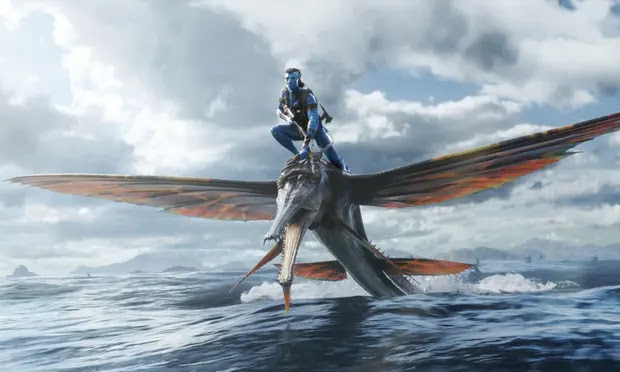Viewing the teaser for Avatar: The Way of Water on my laptop felt like being forced to look at someone’s holiday photos. Let’s hope James Cameron’s 3D sequel has more depth to it than just nice scenery
Variety wrote breathlessly: “Exhibitors were immersed into different regions across the dazzling world of Pandora through sweeping visuals of the planet’s crystal blue oceans and lakes.” Forbes, meanwhile, was so blown away by the non-stop 3D extravaganza that it claimed Avatar had “won” CinemaCon. The message from anyone who saw the trailer was clear: Avatar is back, and ready to knock your socks off all over again.
Well, luckily for us the Avatar 2 trailer went online yesterday, giving us lowly non-exhibitors a chance to have our brains splattered out of the back of our skulls as well. And, upon watching it, there’s a good chance that we all had the same thought at the same time. Wait, are we watching the thing that they watched?
Because the trailer that dropped on YouTube really isn’t particularly spectacular. Some Na’vi jump across a tree. A sort of lizardy bird thing flies across some water. Some characters go for a bit of a swim. Sam Worthington’s character looks like he’s doing his best to hold in a fart. And, apart from the soundtrack – which is effectively the sound of Enya passing out from boredom and landing on a synthesiser – that’s about it.
Look, Avatar happened a long time ago. And, even though its cultural cachet has long since been eroded by the deathless onslaught of superhero movies, people loved it at the time. They got to go to the cinema and wear a special pair of glasses and be blown away by all the best visuals that 2009 could muster.
I saw Avatar at the cinema twice, for example. However, can I remember a single thing about it? Not really. There were blue people, and something called unobtanium, and an angry man ripping off the final act of Aliens as hard as he could, but that’s about it.
If James Cameron is serious about making a long-dormant franchise like Avatar a going concern again – and he is, as his endless convoy of planned sequels will attest – then this trailer seems a bit like a misstep. There isn’t a trace of premise here, or character, or any real action to speak of. Instead, we’re given a minute and a half of nice-looking scenery. It’s like being held hostage to look at someone’s holiday photos.
Now, there is a chance that my viewing conditions aren’t exactly ideal. Avatar has always been about watching something beautiful on a giant screen, through special glasses that make you feel completely immersed. This is how the CinemaCon attendees got to see the trailer, and perhaps that explains their awestruck reactions. Meanwhile, I watched it on a four-inch YouTube window at my desk on a sunny day while eating an apple. The conditions couldn’t be more mundane, and you suspect that James Cameron would melt like an Indiana Jones baddie if he ever caught anyone sullying his work like that.
But this is how nine million people, and counting, have experienced the trailer. Far, far more people have watched it on laptops, or phones, or smartwatches for crying out loud, than in cinemas. And that will also extend to the film itself. For everyone who will pay to see Avatar 2 at the cinema like Cameron intended, scores more will wait for it to turn up for free on Disney+. And if the best thing that the film has going for it is lovely scenery that can only be properly appreciated through 3D glasses, that might be a problem.
But it’s still early days. In truth, the Avatar 2 trailer felt less like a trailer and more like a tech demo. We still have months before the film is released. Maybe in the next trailer, stuff could actually happen. Wouldn’t that be novel?
we have a small favour to ask. Tens of millions have placed their trust in the Guardian’s fearless journalism since we started publishing 200 years ago, turning to us in moments of crisis, uncertainty, solidarity and hope. More than 1.5 million supporters, from 180 countries, now power us financially – keeping us open to all, and fiercely independent.
Unlike many others, the Guardian has no shareholders and no billionaire owner. Just the determination and passion to deliver high-impact global reporting, always free from commercial or political influence. Reporting like this is vital for democracy, for fairness and to demand better from the powerful.
And we provide all this for free, for everyone to read. We do this because we believe in information equality. Greater numbers of people can keep track of the global events shaping our world, understand their impact on people and communities, and become inspired to take meaningful action. Millions can benefit from open access to quality, truthful news, regardless of their ability to pay for it.
If there were ever a time to join us, it is now. Every contribution, however big or small, powers our journalism and sustains our future. Support the Guardian from as little as $1 – it only takes a minute. Thank you.

